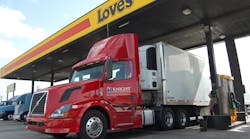Growth in U.S., food consumption, more regionalized distribution patterns, a strong harvest and tight freight capacity are helping create extra and more profitable demand for temperature-controlled trucking operations – with the particular route structures of refrigerated truckload carriers going a long way to determine winners and losers.
“Temperature controlled freight has proven to be the less cyclical than dry van, flatbed, or tank so we’re in a good sector from that perspective,” noted John Larkin, a managing director and head of transportation research at Wall Street investment firm Stifel, Nicolaus & Co.
“Going forward, we believe margins are going to improve as prices grow faster than costs,” he said during an industry presentation last week. “We’re not saying that costs won’t rise – they will – but margins and return on capital should improve as the big get bigger and the small struggle and fall away or consolidate into bigger players. To that end, there will likely be an increase in M&A [merger and acquisition] activity.”
Larkin believes the “best years” are ahead for the trucking industry as a whole, despite challenges posed by the driver shortage and regulatory overload, but particularly for the refrigerated segment of the industry where demand is “pretty solid” in his estimation.
“People have to eat; certain members of our population need to use cosmetics. And demand for healthcare, pharmaceuticals, etc., which needs to be temperature protected continues to be strong,” Larkin explained. “We’re always going to need those things.”
Some of the trends fueling increased demand for temperature-controlled trucking include: 0.6% annual growth in U.S. per capita food expenditures since 1954; overall U.S. population growth of 1.1% per year; a 1.3% compound annual growth rate (CAGR) in both domestic and imported frozen foods; and increased regionalization of the U.S. distribution network in part to deliver more fresh/organic foodstuffs.
“That’s good, steady growth which creates a great opportunity,” Larkin pointed out. “As well, as we focus more and more on fresh food, eating healthy, etc., and many retailers have opted for regional sourcing strategies. There’s a limit to how much regional sourcing you can do due to weather constraints, growing seasons, and so forth, but in general we’re becoming a little bit more of a regionalized distribution network in the U.S.”
More near-term tends are also reflecting growing demand for refrigerated trucking services as well. Mark Montague, manager of industry pricing for DAT Solutions, told Fleet Owner that the firm’s load board numbers for refrigerated freight remain “solidly ahead” of 2013.
“July demand was 15% higher than 2013 and rates were up 8.8% in the spot market, year-over-year,” he noted. “Looking at crop expectations combined with better meat supplies, the expectation is that rates will remain elevated through the fall harvest season.”
Typical for this time of year, DAT said it is seeing seasonal refrigerated rate changes based on the particular foodstuffs produced in certain U.S. regions.
For example, eastern Washington is gaining strength in refrigerated freight volume along with the Upper Midwest and upstate New York, said Montague, while meat production from states like Colorado, Kansas, Nebraska, and Texas is coming back on stream along with volume of other products that typically gain strength during back-to-school season, like cheese, yogurt, and fresh fruit.
That’s encouraging many refrigerated carriers to expand. For example, back in June, Knight Transportation created a new refrigerated division – Kool Trans, LLC – and hired Jon Isaacson, formerly of Central Refrigerated, to run it; even though it already operates a temperature-controlled subsidiary, Knight Refrigerated.
While Craig Robbins, head of Robbins Consulting, noted that Kool Trans – which will operate 50 tractors initially but plans to expand to between 150 to 200 over the next year and half – has the potential to cannibalize Knight’s existing reefer business, he said Knight’s management feels this is unlikely at least near term as the customer base is large enough to support both businesses.
Stifel’s Larkin noted, however, that while demand continues to grow for refrigerated trucking services, it’s also undergoing major change due to demographic shifts in the U.S. – a development that may benefit certain carriers more than others based on their operational foodprint.
“You find that half of the U.S. population lives in [major] urban concentrations now in: southern California; Phoenix and Scottsdale, AZ; Miami/South Florida; the Northeast corridor: Chicago, IL; plus Dallas and Houston, TX,” he explained. “And that’s about it. There aren’t a lot of people living out in the inner lands [and] this concentration of population is going to continue to accelerate as more and more young people look to live in the city.”
So, what is the right distribution model for a re-urbanized population?
“It’s to place the fulfillment center right in the middle of the city,” Larkin said. “That’s great if you’re a truckload carrier that moves freight into the fulfillment center, but it’s not so great if you’re a truckload carrier that operates in a private fleet type environment or dedicated fleet environment running from a rurally-located regional distribution center to stores. That’s a model that probably is on the decline.”



